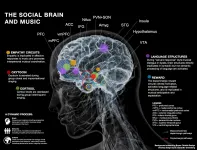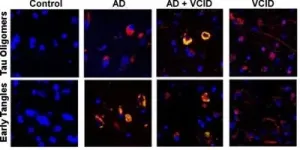Leaders who embrace on-job learning and listen to employees have more resilient teams, research show
2021-06-10
(Press-News.org) HOUSTON - (June 10, 2021) - Leaders who encourage their employees to learn on the job and speak up with ideas and suggestions for change have teams that are more effective and resilient in the face of unexpected situations, according to new research from Rice University and the University of Windsor.
"A Resource Model of Team Resilience Capacity and Learning" will appear in a special issue of Group & Organization Management. Authors Kyle Brykman, an assistant professor at the Odette School of Business at the University of Windsor, and Danielle King, an assistant professor of psychological sciences at Rice, studied what makes employees more resilient and fosters learning in the workplace. The researchers specifically examined the interactions of 48 teams from five Canadian technology startups.
"Understanding what organizations can do to help employees become more resilient is the focus our work in my WorKing Resilience Research Laboratory," King said. "This research project offered an opportunity to uncover the important role of leadership and employee voice in the resilience process."
Brykman and King found that teams that were more effective and resilient if their bosses encourage employees to take risks, make suggestions and learn from the process. Creating a work environment centered around learning and open communication is helpful as teams grow and take on new tasks, King said. Leaders must reinforce this workplace culture with positive language that signals openness and a focus on their development, she said.
"Knowing that you have a leader who is focused on learning and not just on performance outcomes is critical," King said. "It's also important for them to be intentional about communicating this regularly to employees, as it can make all the difference in building more resilient teams. Leaders need to verbally reward a learning mindset. For example, when a boss responds to an employee who makes an on-the-job error by saying, 'Great, now you can learn from this experience,' rather than berating them for making a mistake, it makes a big difference."
To request a copy of the study, contact Amy McCaig, senior media relations specialist at Rice, at 713-348-6777 or amym@rice.edu.
INFORMATION:
This news release can be found online at END
ELSE PRESS RELEASES FROM THIS DATE:
2021-06-10
Music is a tool that has accompanied our evolutionary journey and provided a sense of comfort and social connection for millennia. New research published today in the American Psychologist provides a neuroscientific understanding of the social connection with a new map of the brain when playing music.
A team of social neuroscientists from Bar-Ilan University and the University of Chicago introduced a model of the brain that sheds light on the social functions and brain mechanisms that underlie the musical adaptations used for human connection. The model is unique because it focuses on what happens in the brain when people make music together, rather than when they listen to music individually.
The research was inspired by creative efforts of people around the world to reproduce ...
2021-06-10
Chestnut Hill, Mass. (6/10/2021) - A British man who rejected the standard of care to treat his brain cancer has lived with the typically fatal glioblastoma tumor growing very slowly after adopting a ketogenic diet, providing a case study that researchers say reflects the benefits of using the body's own metabolism to fight this particularly aggressive cancer instead of chemo and radiation therapy.
Published recently in the journal Frontiers in Nutrition, the report is the first evaluation of the use of ketogenic metabolic therapy (KMT) without chemo or radiation interventions, on a patient diagnosed with IDH1-mutant glioblastoma (GBM). Ketogenic therapy is a non-toxic nutritional approach, viewed as complementary or ...
2021-06-10
Just as the governor announced the start of python hunting season in Florida this month, researchers at the University of Central Florida have published a first- of-its-kind study that shows that near-infrared (NIR) spectrum cameras can help hunters more effectively track down these invasive snakes, especially at night.
The snakes, which can reach 26 feet in length and 200 pounds, have invaded the Everglades in Florida -- threatening native species and disrupting the ecosystem. The number of common native species observed in the Everglades since the snakes were first discovered in the 1990s dropped in some species by 90% through 2010, according ...
2021-06-10
ITHACA, N.Y. - Researchers from Cornell University's School of Applied and Engineering Physics and Samsung's Advanced Institute of Technology have created a first-of-its-kind metalens - a metamaterial lens - that can be focused using voltage instead of mechanically moving its components.
The proof of concept opens the door to a range of compact varifocal lenses for possible use in many imaging applications such as satellites, telescopes and microscopes, which traditionally focus light using curved lenses that adjust using mechanical parts. In some applications, moving traditional glass or plastic lenses ...
2021-06-10
Climate change exerts great pressure for change on species and biodiversity. A recent study conducted by the University of Helsinki and the Finnish Environment Institute indicates that the few moth and butterfly species (Lepidoptera) capable of adjusting to a changing climate by advancing their flight period and moving further north have fared the best in Finland. In contrast, roughly 40% of Lepidoptera species have not been able to respond in either way, seeing their populations decline.
Climate change is bringing about rapid change in Finnish nature - can species keep up with the pace? Adjusting to climate change can manifest through earlier phenology such as moth and butterfly flight periods, bird nesting, or ...
2021-06-10
Researchers remain perplexed as to what causes dementia and how to treat and reverse the cognitive decline seen in patients. In a first-of-its-kind study, researchers at the Medical University of South Carolina (MUSC) and Beth Israel Deaconess Medical Center (BIDMC), Harvard Medical School discovered that cis P-tau, a toxic, non-degradable version of a healthy brain protein, is an early marker of vascular dementia (VaD) and Alzheimer's disease (AD). Their results, published on June 2 in Science Translational Medicine, define the molecular mechanism that causes an accumulation of this toxic protein. Furthermore, they showed that ...
2021-06-10
WACO, Texas (June 9, 2021) - Most people listen to music throughout their day and often near bedtime to wind down. But can that actually cause your sleep to suffer? When sleep researcher Michael Scullin, Ph.D., associate professor of psychology and neuroscience at Baylor University, realized he was waking in the middle of the night with a song stuck in his head, he saw an opportunity to study how music -- and particularly stuck songs -- might affect sleep patterns.
Scullin's recent study, published in Psychological Science, investigated the relationship between music listening and sleep, focusing on a rarely-explored mechanism: involuntary musical imagery, or "earworms," when a song or tune replays ...
2021-06-10
June 10, 2021, CLEVELAND: A new Cleveland Clinic-led study has identified mechanisms by which COVID-19 can lead to Alzheimer's disease-like dementia. The findings, published in Alzheimer's Research & Therapy, indicate an overlap between COVID-19 and brain changes common in Alzheimer's, and may help inform risk management and therapeutic strategies for COVID-19-associated cognitive impairment.
Reports of neurological complications in COVID-19 patients and "long-hauler" patients whose symptoms persist after the infection clears are becoming more common, suggesting that SARS-CoV-2 (the virus that causes COVID-19) may have lasting effects on brain function. However, it is not yet well understood how the virus leads to neurological issues.
"While some studies suggest ...
2021-06-10
The human heart contracts about 70 times per minute, while that of a rat contracts over 300 times; what accounts for this difference? In a new study publishing 10th June in the open-access journal PLOS Biology, led by Michael Geeves and Mark Wass of the University of Kent and Leslie Leinwand from the University of Colorado Boulder, reveal the molecular differences in the heart muscle protein beta myosin that underly the large difference in contraction velocity between the two species.
Myosin is a "molecular motor" - an intricate nanomachine that forms the dynamic core of a muscle's contractile machinery, burning ...
2021-06-10
Pairing sky-mapping algorithms with advanced immunofluorescence imaging of cancer biopsies, researchers at The Mark Foundation Center for Advanced Genomics and Imaging at Johns Hopkins University and the Bloomberg~Kimmel Institute for Cancer Immunotherapy developed a robust platform to guide immunotherapy by predicting which cancers will respond to specific therapies targeting the immune system.
A new platform, called AstroPath, melds astronomic image analysis and mapping with pathology specimens to analyze microscopic images of tumors.
Immunofluorescent imaging, using antibodies with fluorescent tags, enables researchers to visualize multiple cellular proteins simultaneously and determine their pattern and strength of expression. Applying AstroPath, ...
LAST 30 PRESS RELEASES:
[Press-News.org] Leaders who embrace on-job learning and listen to employees have more resilient teams, research show






